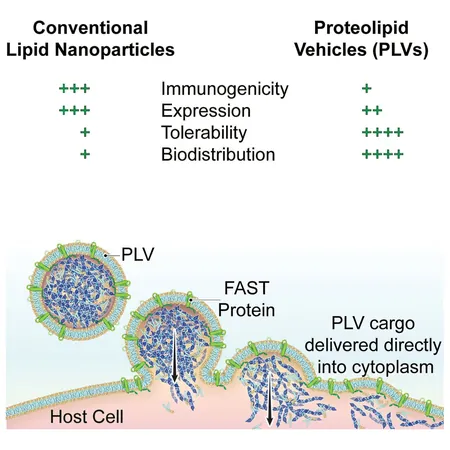
Breakthrough Drug Delivery System Overcomes Major Challenge for Gene Therapies!
2024-10-23
Author: Ming
Introduction
In an exciting development led by researchers at the University of Alberta, a new drug delivery system has surfaced that could significantly improve the efficacy of gene therapies in treating serious conditions. By leveraging the unique abilities of viruses to bypass a critical obstacle in drug delivery, this revolutionary approach is set to reshape genetic medicine as we know it.
The Challenge of Current Delivery Systems
Dr. John Lewis, an oncologist and the lead author of the study, explains that one of the biggest hurdles in delivering therapeutic agents is the liver. 'Current delivery systems may sound promising in theory, but they exhibit a critical shortcoming—they tend to gravitate towards the liver,' says Lewis, also a member of the Cancer Research Institute of Northern Alberta. 'For patients with brain or lung diseases, for instance, targeting the liver is counterproductive. We need tailored solutions to direct therapies to specific tissues and cells.'
Most current lipid nanoparticle (LNP) technologies, which include key ingredients like cholesterol, unfortunately accumulate in the liver. This accumulation leads to the early elimination of essential genetic medicines—including gene therapies, mRNA vaccines, and gene editing technologies—before they can reach their intended targets.
Collaboration and Development of FAST-PLV
In a quest for effective delivery that circumvents the liver, Lewis has partnered with virologist Roy Duncan from Dalhousie University. Duncan is renowned for discovering a unique fusogenic orthoreovirus protein capable of fusing cells together. Their promising findings have been published in the journal Cell.
Together, they formulated a revolutionary proteolipid vehicle called FAST-PLV, which combines this fusion protein with a specially modified lipid nanoparticle. Remarkably, this new platform successfully circumvents the liver, allowing therapies to effectively target critical areas like the brain and lungs. Additionally, FAST-PLV is less toxic compared to existing delivery systems and avoids triggering immune responses, enabling repeated dosing—a crucial factor for managing chronic conditions that may require multiple treatments.
Promising Results with Muscle-Development Gene Therapy
To showcase the potential of their innovative delivery platform, Lewis and his team engineered a gene therapy involving a muscle-development protein associated with the famous Belgian Blue cattle. In their experiments on mice, the FAST-PLV platform not only avoided the liver but also resulted in an astonishing 100% increase in muscle mass compared to untreated mice. This breakthrough could hold promise for treating muscle-wasting diseases like frailty and sarcopenia.
A Versatile Solution for Gene Therapies
'This platform is essentially a plug-and-play solution,' asserts Lewis. 'It can be used by researchers developing various gene editing techniques and therapies for non-liver diseases to enhance the creation of their drugs.'
Future Prospects and Ambitious Plans
The team has ambitious plans, with a new COVID-19 vaccine soon entering Phase 2 clinical trials. Additionally, trials targeting Stargardt’s disease might commence within the next two years, while exciting research is already underway in the realm of cancer treatments. Lewis initially zeroed in on cancer therapies to explore genetic alternatives to conventional chemotherapy.
Addressing Serious Genetic Disorders
The vision doesn't stop there. Lewis anticipates that this platform could potentially lead to cures for serious genetic disorders, including muscular dystrophy, cystic fibrosis, Alzheimer’s, and Parkinson's diseases. 'The technology holds the potential to address and potentially cure devastating diseases that affect children with genetic mutations,' he explains.
Conclusion
This groundbreaking advancement represents more than just a tech improvement—it signifies a fundamental shift in the landscape of genetic disease treatment, with the capacity to change lives worldwide. 'We are at the dawn of what this innovation can offer; with the right collaborations and focus, the possibilities are limitless!' Lewis concludes enthusiastically.
As we move forward in this age of rapid scientific advancements, this research is a beacon of hope for those affected by previously untreatable conditions, hinting at a future where cures could be within reach for millions. Stay tuned, as we continue to follow the potential game-changing implications of this research!



 Brasil (PT)
Brasil (PT)
 Canada (EN)
Canada (EN)
 Chile (ES)
Chile (ES)
 España (ES)
España (ES)
 France (FR)
France (FR)
 Hong Kong (EN)
Hong Kong (EN)
 Italia (IT)
Italia (IT)
 日本 (JA)
日本 (JA)
 Magyarország (HU)
Magyarország (HU)
 Norge (NO)
Norge (NO)
 Polska (PL)
Polska (PL)
 Schweiz (DE)
Schweiz (DE)
 Singapore (EN)
Singapore (EN)
 Sverige (SV)
Sverige (SV)
 Suomi (FI)
Suomi (FI)
 Türkiye (TR)
Türkiye (TR)